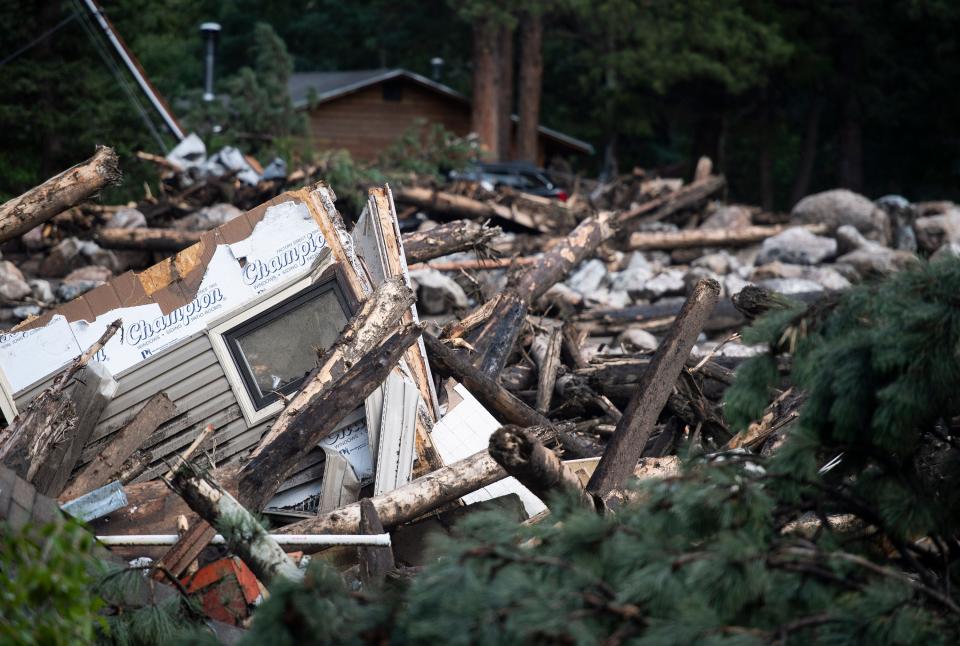Yes, Colorado has a monsoon season. Here's how it impacts flash flooding
As unlikely as it might seem, Colorado has a monsoon season, and its impact can be devastating.
The National Weather Service said the July 15 fatal flash flood in the Crystal Mountain and Buckhorn Canyon area was caused by a brief downpour from monsoonal moisture on the Cameron Peak Fire burn scar.
The weather service said many of the state's most devastating floods have taken place during the monsoon season, including the 1976 Big Thompson flood and 1997 Spring Creek flood in Fort Collins, both of which occurred in late July.
The past two summers, monsoon-influenced flash floods closed Interstate 70 in the Grizzly Creek Fire burn scar in Glenwood Canyon. Last July, a flash flood killed four people in the Upper Poudre Canyon.

When is the Colorado monsoon season?
The North American monsoon season officially starts June 15. It generally begins in the southwestern U.S. and if strong enough can reach Colorado and even into Wyoming, generally July into late August, according to the Colorado Climate Center.
How does the monsoon form?
The center said the monsoon pattern is created by abundant moisture that builds in the atmosphere from the Gulf of Mexico and the Baja peninsula area.
A shift in wind pattern results from a high-pressure system with clockwise flow over the Rocky Mountains and low pressure near the Gulf of Mexico with a counterclockwise flow that settles over the region and funnels moisture northward into the atmosphere.
Becky Bolinger, assistant state climatologist, said the abundant moisture in the air column needs some instability and lift to let loose. She said when those conditions are right, afternoon thunderstorms form and "it's like a sponge being wrung out.''
Sign up for these Larimer County emergency alerts. They could save your life
How does the monsoon create flash floods?
Brief but heavy rain on burn scars can quickly create flash floods. The weather service said a gauge near Crystal Mountain, which is above Buckhorn Canyon, received 0.91 inches of rain in an hour on July 15, including 0.67 inches in 20 minutes.
The charred soil repels water quickly, sending a torrent down rivers, creeks, canyons, gullies and ravines that act as funnels of accumulating water. As it gains momentum, the flood brings with it soil, large boulders and burned trees that can destroy homes and claim lives.
What is this year's monsoon season looking like?
Bolinger said this year's monsoon has been hit or miss in Colorado.
She said the monsoon was more active and consistent in June and less consistent in July. A persistent large high-pressure ridge in recent weeks, which has caused sweltering temperatures, has largely blocked the monsoon flow from extending to the Front Range, Bolinger said.
"The high pressure has not been in an ideal position to bring flow in,'' Bolinger said. "It's been really hot down here, and that makes it harder to turn that moisture aloft into precipitation. More commonly, we are seeing virga (rain that doesn't reach the ground). The mountains are a little cooler and so they are getting more opportunity for that moisture to turn into precipitation.''
Heat advisory? Special weather statement? Here's what these weather watches, warnings mean
Any signs the monsoon will return?
On Friday, Bolinger said the seven-day precipitation outlook is much wetter and shows temperatures will become more seasonal, dropping to the high 80s.
The weather service on Friday said the Cameron Peak burn scar area was expected to see elevated flash flood risk starting Saturday afternoon and all day Sunday, with Sunday having the greatest risk for flooding.
"We want that moisture, but with a more active monsoon it will also increase the risk of flooding on the burn scars,'' Bolinger said.
Flash flood survivor:'When they say flash flood, take it seriously.'
Reporter Miles Blumhardt looks for stories that impact your life. Be it news, outdoors, sports — you name it, he wants to report it. Have a story idea? Contact him at milesblumhardt@coloradoan.com or on Twitter @MilesBlumhardt.
Support his work and that of other Coloradoan journalists by purchasing a digital subscription today.
This article originally appeared on Fort Collins Coloradoan: Colorado has a monsoon season; here's how it impacts flash flooding

